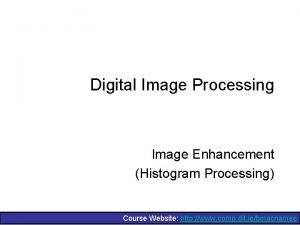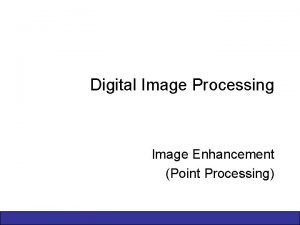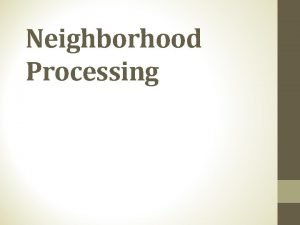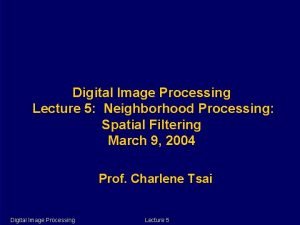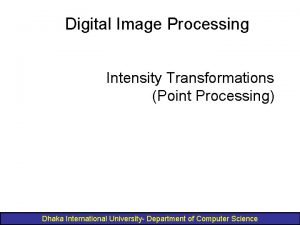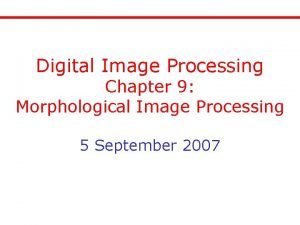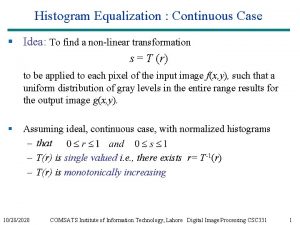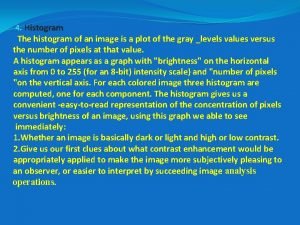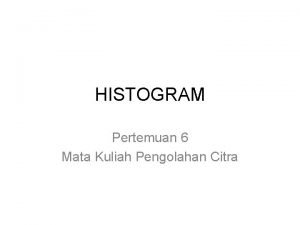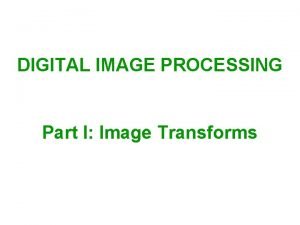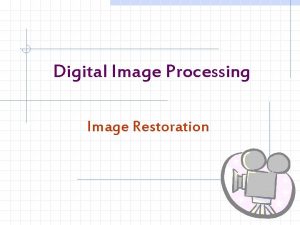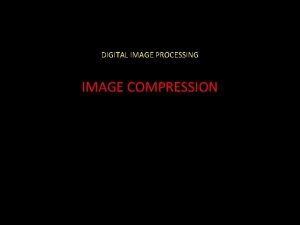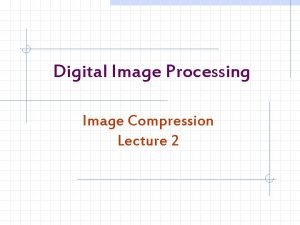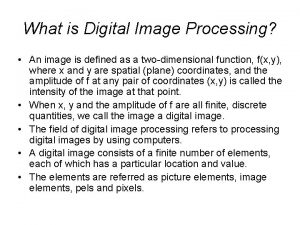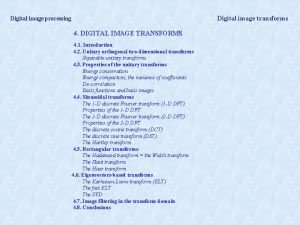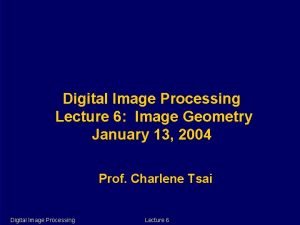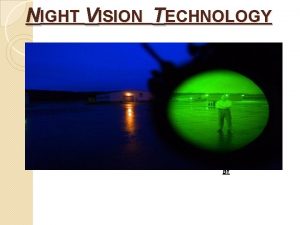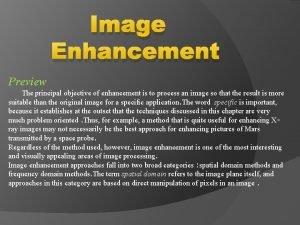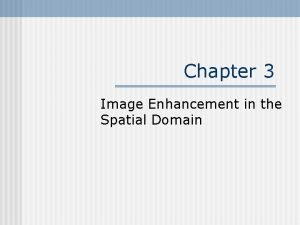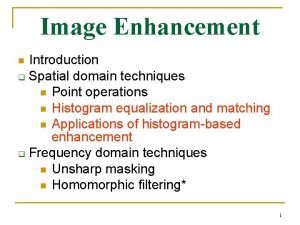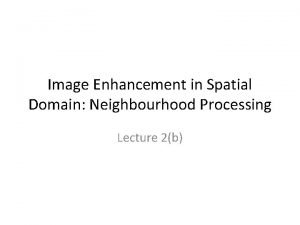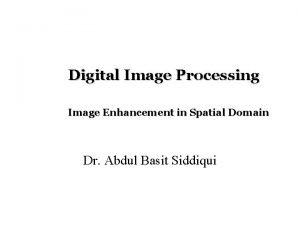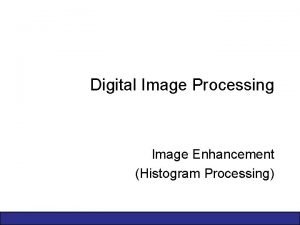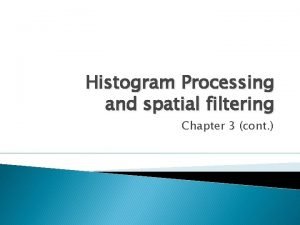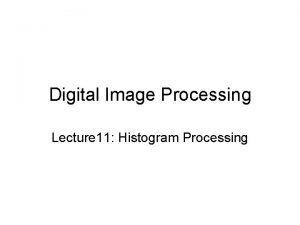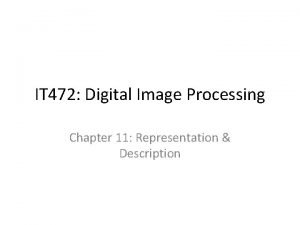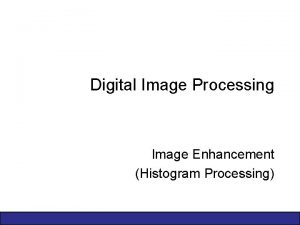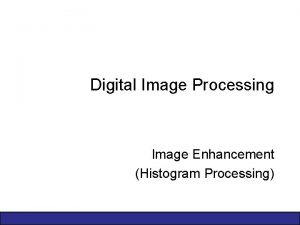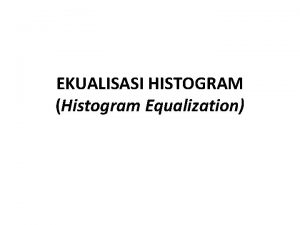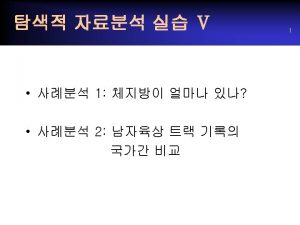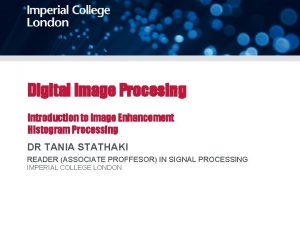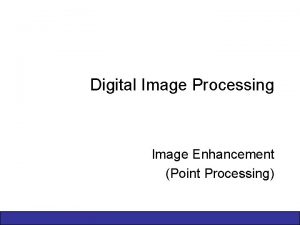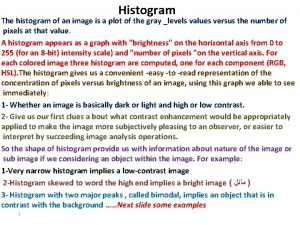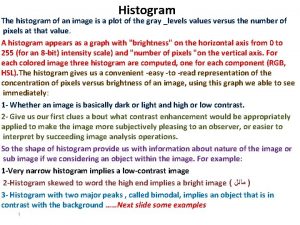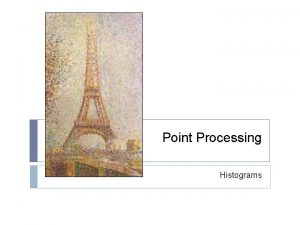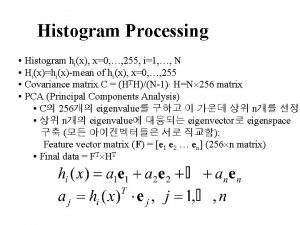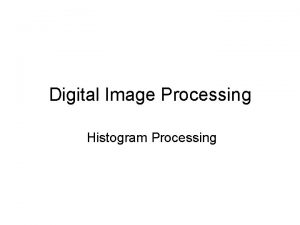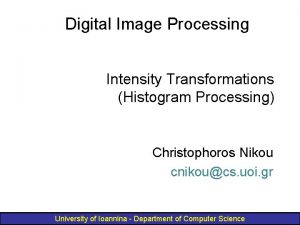Digital Image Processing Image Enhancement Histogram Processing Course

































- Slides: 33

Digital Image Processing Image Enhancement (Histogram Processing) Course Website: http: //www. comp. dit. ie/bmacnamee

2 of 32 Come To The LABS! Day: Wednesday Time: 9: 00 – 11: 00 Room: Aungier St. 1 -005 We will start by getting to grips with the basics of Scilab – Lab details available at Web. CT Shortly, there will be a Scilab assignment which will count towards your final mark

3 of 32 Contents Over the next few lectures we will look at image enhancement techniques working in the spatial domain: – What is image enhancement? – Different kinds of image enhancement – Histogram processing – Point processing – Neighbourhood operations

4 of 32 A Note About Grey Levels So far when we have spoken about image grey level values we have said they are in the range [0, 255] – Where 0 is black and 255 is white There is no reason why we have to use this range – The range [0, 255] stems from display technologes For many of the image processing operations in this lecture grey levels are assumed to be given in the range [0. 0, 1. 0]

5 of 32 What Is Image Enhancement? Image enhancement is the process of making images more useful The reasons for doing this include: – Highlighting interesting detail in images – Removing noise from images – Making images more visually appealing

Images taken from Gonzalez & Woods, Digital Image Processing (2002) 6 of 32 Image Enhancement Examples

Images taken from Gonzalez & Woods, Digital Image Processing (2002) 7 of 32 Image Enhancement Examples (cont…)

Images taken from Gonzalez & Woods, Digital Image Processing (2002) 8 of 32 Image Enhancement Examples (cont…)

Images taken from Gonzalez & Woods, Digital Image Processing (2002) 9 of 32 Image Enhancement Examples (cont…)

10 of 32 Spatial & Frequency Domains There are two broad categories of image enhancement techniques – Spatial domain techniques • Direct manipulation of image pixels – Frequency domain techniques • Manipulation of Fourier transform or wavelet transform of an image For the moment we will concentrate on techniques that operate in the spatial domain

11 of 32 Image Histograms Frequencies The histogram of an image shows us the distribution of grey levels in the image Massively useful in image processing, especially in segmentation Grey Levels

Images taken from Gonzalez & Woods, Digital Image Processing (2002) 12 of 32 Histogram Examples

Images taken from Gonzalez & Woods, Digital Image Processing (2002) 13 of 32 Histogram Examples (cont…)

Images taken from Gonzalez & Woods, Digital Image Processing (2002) 14 of 32 Histogram Examples (cont…)

Images taken from Gonzalez & Woods, Digital Image Processing (2002) 15 of 32 Histogram Examples (cont…)

Images taken from Gonzalez & Woods, Digital Image Processing (2002) 16 of 32 Histogram Examples (cont…)

Images taken from Gonzalez & Woods, Digital Image Processing (2002) 17 of 32 Histogram Examples (cont…)

Images taken from Gonzalez & Woods, Digital Image Processing (2002) 18 of 32 Histogram Examples (cont…)

Images taken from Gonzalez & Woods, Digital Image Processing (2002) 19 of 32 Histogram Examples (cont…)

Images taken from Gonzalez & Woods, Digital Image Processing (2002) 20 of 32 Histogram Examples (cont…)

Images taken from Gonzalez & Woods, Digital Image Processing (2002) 21 of 32 Histogram Examples (cont…)

Images taken from Gonzalez & Woods, Digital Image Processing (2002) 22 of 32 Histogram Examples (cont…) A selection of images and their histograms Notice the relationships between the images and their histograms Note that the high contrast image has the most evenly spaced histogram

23 of 32 Contrast Stretching We can fix images that have poor contrast by applying a pretty simple contrast specification The interesting part is how do we decide on this transformation function?

24 of 32 Histogram Equalisation Spreading out the frequencies in an image (or equalising the image) is a simple way to improve dark or washed out images The formula for histogram equalisation is given where – rk: input intensity – sk: processed intensity – k: the intensity range (e. g 0. 0 – 1. 0) – nj: the frequency of intensity j – n: the sum of all frequencies

Images taken from Gonzalez & Woods, Digital Image Processing (2002) 25 of 32 Equalisation Transformation Function

Images taken from Gonzalez & Woods, Digital Image Processing (2002) 26 of 32 Equalisation Examples 1

Images taken from Gonzalez & Woods, Digital Image Processing (2002) 27 of 32 Equalisation Transformation Functions The functions used to equalise the images in the previous example

Images taken from Gonzalez & Woods, Digital Image Processing (2002) 28 of 32 Equalisation Examples 2

Images taken from Gonzalez & Woods, Digital Image Processing (2002) 29 of 32 Equalisation Transformation Functions The functions used to equalise the images in the previous example

Images taken from Gonzalez & Woods, Digital Image Processing (2002) 30 of 32 Equalisation Examples (cont…) 3 4

Images taken from Gonzalez & Woods, Digital Image Processing (2002) 31 of 32 Equalisation Examples (cont…) 3 4

Images taken from Gonzalez & Woods, Digital Image Processing (2002) 32 of 32 Equalisation Transformation Functions The functions used to equalise the images in the previous examples

33 of 32 Summary We have looked at: – Different kinds of image enhancement – Histograms – Histogram equalisation Next time we will start to look at point processing and some neighbourhood operations
 Histogram processing in digital image processing
Histogram processing in digital image processing Image enhancement point processing techniques
Image enhancement point processing techniques Neighborhood processing
Neighborhood processing Nonlinear image processing
Nonlinear image processing What is point processing in digital image processing
What is point processing in digital image processing Digital image processing
Digital image processing Histogram equalisation in image processing
Histogram equalisation in image processing Histogram shrinking
Histogram shrinking Histogram image processing
Histogram image processing Image transform in digital image processing
Image transform in digital image processing Linear position invariant degradation
Linear position invariant degradation Compression models in digital image processing
Compression models in digital image processing Key stage in digital image processing
Key stage in digital image processing Variable length coding in digital image processing
Variable length coding in digital image processing Image sharpening in digital image processing
Image sharpening in digital image processing Image geometry in digital image processing
Image geometry in digital image processing Zooming and shrinking in digital image processing
Zooming and shrinking in digital image processing Walsh transform in digital image processing
Walsh transform in digital image processing Maketform matlab
Maketform matlab Noise
Noise Digital print enhancement
Digital print enhancement Gray level slicing
Gray level slicing Image enhancement in night vision technology
Image enhancement in night vision technology Objective of image enhancement
Objective of image enhancement Pelembutan citra
Pelembutan citra Combining spatial enhancement methods
Combining spatial enhancement methods Image enhancement in spatial domain
Image enhancement in spatial domain Image enhancement in spatial domain
Image enhancement in spatial domain Image enhancement in spatial domain
Image enhancement in spatial domain Gonzalez
Gonzalez Histogram
Histogram Histogram processing
Histogram processing Minimum perimeter polygon in digital image processing
Minimum perimeter polygon in digital image processing Representation and description in digital image processing
Representation and description in digital image processing
